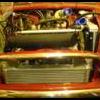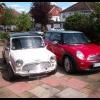While the A-Series was a remarkable engine, would have to vehemently disagree on the notion it would have been pointless to update / evolve the engine further than what was already done let alone concede the do-nothing approach was the best one to take. The 1300 Triumph engine is irrelevant prior to the formation of BL, beyond possessing odd valuable feature like an 8-port head that belong on an updated A-Series.
The existing A-Series engines inability to grow to 1.6-litres handicapped a number of critical models that could have otherwise been remedied by a linear low/mid-range A-Series successor akin to the 1000-1600cc Nissan A / Series 2 E engines. Such an engine would have still been in essence an A-Series with some carry over or interchangeability from the existing unit, yet minus most of the limitations apart from say for example sharing the existing A-Series engine’s reliable power limit of around 120-130 hp in road-going applications*.
It would have butterflied away the necessity of various stillborn A-Series successors (including the V4/V6 blind alley), been a lot cheaper to produce compared to embracing a clean sheet design like the underdeveloped E-Series (in reality a compromised mid/high-range engine that Issigonis / BMC pretended could realistically replace 3 engine families at once) and would have opened up more options for various applications in cars like the Mini, ADO16, Midget, etc.
*-) Around 120-130 hp seems to be the absolute reliable limit for the 1275cc A-Series in tuned road-going form give or take a few hp, yet have read of the MG Metro Turbo originally being capable of up to 130 hp before being significantly detuned to preserve the life of the gearbox.
The 115 hp Nissan E15ET engine used in the Nissan Cherry 1.5 Turbo (and a distant relation to the A-Series) would demonstrate even the most potent of a hypothetical updated A-Series or linear A-Series successor displacing up to 1.6-litres would not have needed to reach the 120-130 hp limit, as it could also serve a similar role to the 1.5 E-Series, 1.6 R/S-Series and 1.7 O-Series (as well as a much lighter alternative to the 1.6 B-Series) in non-performance applications.
Edited by Mite, 24 July 2019 - 04:14 AM.
















